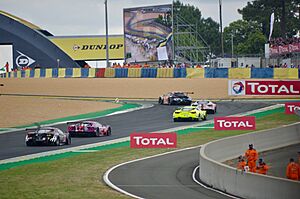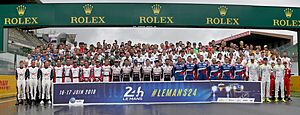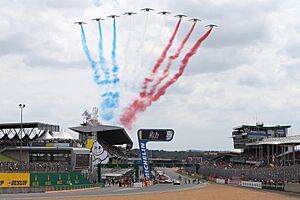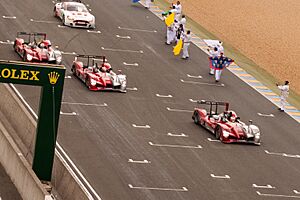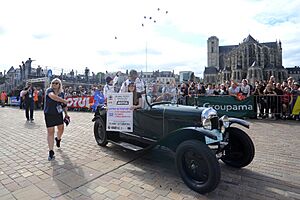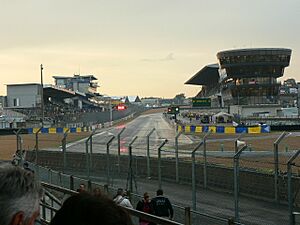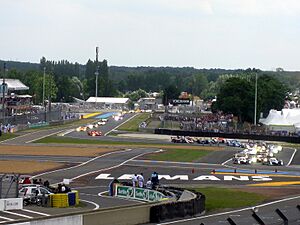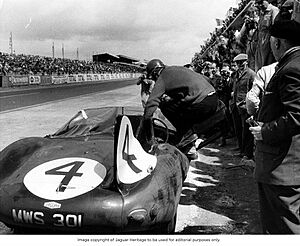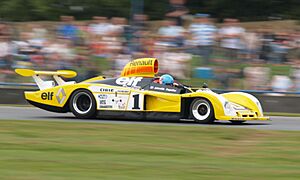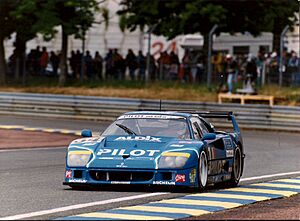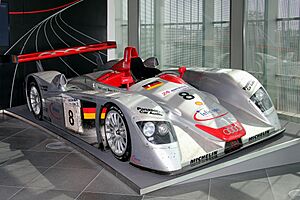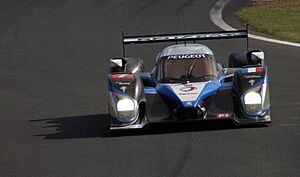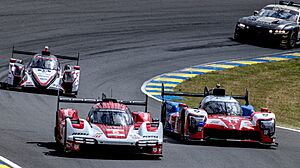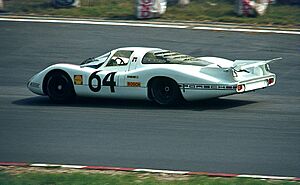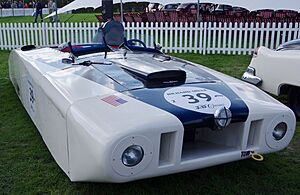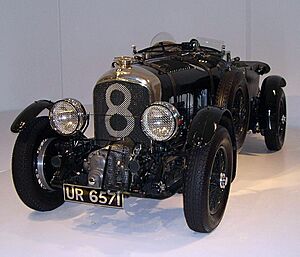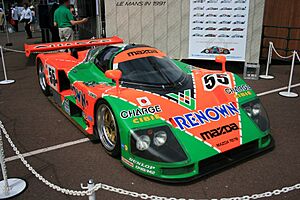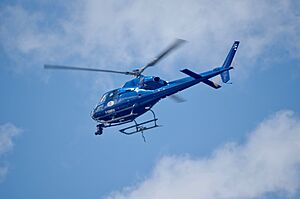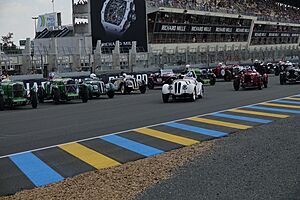24 Hours of Le Mans facts for kids
 |
|
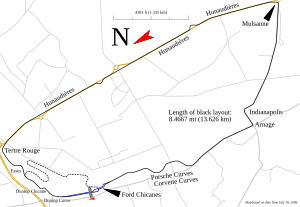 |
|
| FIA World Endurance Championship | |
|---|---|
| Venue | Circuit de la Sarthe |
| Location | 47°57′00″N 00°12′27″E / 47.95000°N 0.20750°E |
| First race | 1923 |
| First WEC race | 2012 |
| Last race | 2025 |
| Distance | 1 lap: 13.626 km (8.467 mi) |
| Duration | 24 hours |
| Most wins (driver) | |
| Most wins (team) | |
| Most wins (manufacturer) | |
The 24 Hours of Le Mans (French: 24 Heures du Mans) is a famous sports car race held every year near Le Mans, France. It is one of the world's most important races. It is also part of the "Triple Crown of Motorsport" along with the Monaco Grand Prix and Indianapolis 500. The race started in 1923, making it the oldest active endurance race in the world.
Unlike races where the winner is the fastest to finish a set distance, Le Mans is won by the car that travels the farthest in 24 hours. Cars on this track can reach speeds of 366 km/h (227 mph). In 1988, a car even reached 407 km/h (253 mph) on the Mulsanne Straight. Because of these high speeds, more turns called chicanes were added to the track to slow cars down. Racing teams need to balance speed with making sure their cars can run for 24 hours without breaking down. The Automobile Club de l'Ouest (ACO) organizes the race. It takes place on the Circuit de la Sarthe, which uses both public roads and special racing track sections.
The 24 Hours of Le Mans was often part of the World Sportscar Championship from 1953 to 1992. In 2011, it was part of the Intercontinental Le Mans Cup. Since 2012, the race has been a key event in the FIA World Endurance Championship. There is also a 10-hour American version of the race called Petit Le Mans, which has been held every year since 1998.
Contents
Why the Race Started
When it began, Grand Prix motor racing was very popular in Europe. Le Mans was created to be a different kind of challenge. Instead of just showing which car company could build the fastest machines, the 24 Hours of Le Mans focused on how well manufacturers could build strong and reliable sports cars. This encouraged new ideas for making cars that lasted a long time and used less fuel. In endurance racing, cars need to be tough and spend as little time as possible in the pit stops.
The track's design also meant cars needed good aerodynamics and stability at high speeds. While Grand Prix races also needed this, few tracks had straights as long as the Mulsanne Straight. Also, because parts of the track are public roads, they are not as smooth as dedicated race tracks. This puts more stress on car parts, making reliability even more important.
In the 1970s, the oil crisis led organizers to limit how much fuel each car could use. This rule was called Group C. Even though it was later changed, saving fuel is still important. New fuel sources help cars spend less time in the pits. These new ideas for race cars can also be used in regular cars that people drive every day. This has also led to faster and more exciting supercars.
New hybrid systems, which combine petrol and diesel engines with electric power, have also been used in the Le Mans prototype cars. Rules were changed to encourage these systems, pushing for even more efficient cars.
The Race Day
The race happens in mid-June, around the longest day of the year. This means the night is short, and it can be very hot for drivers, especially in closed cars. Rainy weather is also common. The race starts in the middle of the afternoon and finishes at the same time the next day.
Modern cars often travel more than 5,000 km (3,110 mi). The record is 5,410 km (3,360 mi) from 2010. This is more than six times the length of the Indianapolis 500 race. Drivers and their teams try to be fast while avoiding damage to their cars. They also manage fuel, tires, and braking materials. The race truly tests endurance. Drivers often race for over two hours before another driver takes over during a pit stop. Current rules say that three drivers must share each car. No driver can drive more than 4 hours in a 6-hour period, and no more than 14 hours total.
Cars race in different "classes" based on their type, but they all compete at the same time for the overall win. The race originally featured cars similar to those sold to the public, called "Sports Cars." Over time, the cars became more specialized. Today, there are three main classes:
- Sports prototypes: These are special "hypercar" race cars, the fastest in sports car racing.
- Le Mans Prototypes (LMP): These are also purpose-built race cars.
- Grand Touring (GT) cars: These are based on regular sports cars sold to the public and are generally not as fast as the prototypes.
These classes are further divided into Hypercar (LMH or LMDh), LMP2, and LMGT3 (GT cars).
Teams in the race come in many forms. Some are from big car manufacturers who want to show off their products. Others are professional racing teams with sponsors. There are also amateur teams who just want to compete in this famous race.
Winning Le Mans is often seen as more important than winning the championship itself. The race is also a part of the informal Triple Crown of Motorsport. This links Formula One, IndyCar, and sports car racing wins. It is also part of the "Triple Crown of endurance racing" with the 24 Hours of Daytona and 12 Hours of Sebring. Since 1998, the "Petit Le Mans" has been held as a 10-hour American version of the Le Mans 24 Hours.
Race Cars
About 60 cars compete in the race. Each car must have space for at least two seats, even if the second seat isn't actually there. Cars can have two doors. Open-top cars do not need doors. Since 2014, all top-level LMP1 cars must have a roof for safety. Since 2017, all prototype cars (Hypercar or LMP2) must have closed cockpits.
Even though all cars race at the same time, they are divided into separate classes. A prize is given to the winner of each class, and also to the overall winner. The number of classes has changed over the years, but now there are three: Hypercar, LMP2, and LMGT3.
The Hypercar class (LMH or LMDh) is the top class and started in 2021. It replaced the Le Mans Prototype 1 (LMP1) class. New rules for this class aim to keep costs down while allowing for different car designs.
Next is the LMP2 class. Teams in this class must use one of four approved car frames: ORECA, Ligier, Dallara, or Multimatic/Riley. They all use a standard 4.2-liter Gibson V8 engine. ORECA is the most common LMP2 frame. LMP1 teams do not have these limits on car frames and engines. Their cars are more powerful, lighter, and have more complex aerodynamics, making them much faster. LMP1 cars can also use hybrid technology.
The LMGT3 class features cars that are similar to sports cars you can buy.
Garage 56: Special Cars
Special "concept cars" can race under the "Garage 56" banner. These cars are meant to test new car technologies. They are included in the race results but are not expected to win. Their main goal is to show off new ideas.
The program started in 2012 with the DeltaWing, a unique rocket-shaped car. It showed promise, performing almost as well as LMP2 cars but using much less fuel. However, it had to stop racing after a crash.
In 2013, Garage 56 was planned for the GreenGT H2, a car powered by hydrogen. It would have been the first car without a regular engine to race at Le Mans. But the team decided it wasn't ready. In 2016, the H2 did complete a demonstration lap at Le Mans.
The Nissan ZEOD RC, a hybrid electric car, took the Garage 56 spot in 2014. It had to stop early due to a gearbox problem. However, it did reach its goals of hitting 300 km/h (186.41 mph) and completing the first lap of Le Mans using only electric power at racing speed.
In 2015, there was no Garage 56 entry.
Frederic Sausset, a driver with four amputations, drove a special Morgan LMP2 car in the 2016 race.
In 2021, Garage 56 returned with the SRT41 program. Two of the drivers were paralyzed from the waist down. They became the first disabled teammates to compete in the race's history.
In 2023, a special NASCAR Cup Series Chevrolet Camaro ZL1 stock car raced as the Garage 56 entry. It was driven by seven-time Cup champion Jimmie Johnson, 2009 Formula One world champion Jenson Button, and 2010 Le Mans winner Mike Rockenfeller. This car celebrated NASCAR's 75th anniversary and the race's 100th anniversary.
Garage 56 Entries
| Year | Car | Team | Image | Placement |
|---|---|---|---|---|
| 2012 | DeltaWing | Highcroft Racing |  |
DNF |
| 2013 | GreenGT LMP-H2 | GreenGT | 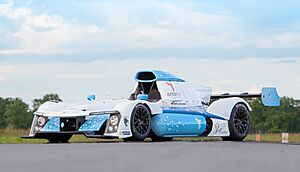 |
Withdrew |
| 2014 | Nissan ZEOD RC | Nissan Motorsports Global | 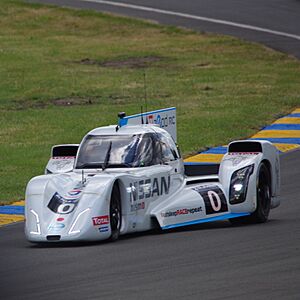 |
DNF |
| 2016 | SRT41 | OAK Racing | 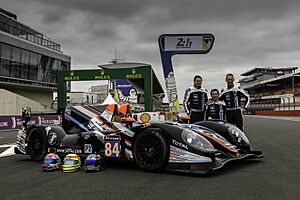 |
38th |
| 2017 | Green4U Panoz Racing GT-EV | Welter Racing |  |
Not Entered |
| 2020 | Association SRT41 | Graff Racing | Withdrew | |
| 2021 | 32nd | |||
| 2023 | Chevrolet Camaro ZL1 | Hendrick Motorsports | 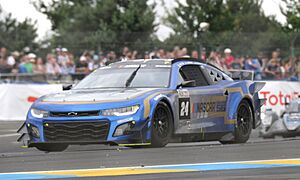 |
39th |
Drivers in the Race
At first, there were no rules about how many drivers a car could have or how long they could drive. Some drivers even tried to race the entire 24 hours by themselves. This practice was later banned. Until the 1980s, some teams used only two drivers. By the end of that decade, rules changed to require at least three drivers per car.
By the 1990s, cars were so fast that new rules were made to prevent drivers from getting too tired. Drivers could not drive for more than 4 hours at a time. Also, no single driver could race for more than 14 hours total. Most teams still use three drivers, even though it's technically possible with two.
In 2017, the driving rules changed again. Officials can now require a driving limit of 80 minutes at a time. Drivers must then take a 30-minute break. This rule applies if the air temperature is at least 32 °C (89.6 °F).
Traditions and Rules
Le Mans has special rules because it is such a long race. For many years, cars could not refuel or add other fluids like oil or coolant for the first hour of the race. This rule was meant to make cars more efficient and reliable. Cars that could not last the first hour without needing fluids risked being disqualified.
Another unique rule is that cars must be turned off while refueling in the pits. This is safer and also tests how reliable the car is, as it must be able to restart many times during the race. Also, mechanics are not allowed to work on the car while it is being refueled. This has made teams find clever ways to make pit stops faster. Drivers can get out and be replaced during refueling. These rules are also used in the FIA World Endurance Championship.
Le Mans has many traditions. The race always starts with the waving of the French flag. This is usually followed by jets flying over, leaving trails of blue, white, and red smoke. Another tradition is track marshals waving safety flags on the final lap to congratulate the winners.
Le Mans was also the first place where a winning driver celebrated by spraying champagne instead of drinking it. In 1967, when Dan Gurney won, he was given a large bottle of champagne. He shook it and sprayed everyone nearby.
Race Schedule
The first race was held on May 26–27, 1923. Since then, it has been held every June, with a few exceptions. In 1956, it was in July. In 1968, it was in September due to political unrest in France. In 2020, it moved to September 19–20 due to the COVID-19 pandemic. In 2021, it moved to August 21–22. The race was canceled ten times: in 1936 due to a labor strike, and from 1940 to 1948 because of World War II.
The race usually takes place on the second weekend of June. Practice and qualifying sessions are held on the Wednesday and Thursday before the race. These sessions are in the evening. Friday is a rest day, and there is a parade of all the drivers through Le Mans.
The race has usually started at 4:00 p.m. local time on Saturday. The 2025 race is also scheduled for 4:00 p.m.
Here are some times the race started differently:
| Year | Start Time | Reason |
|---|---|---|
| 1968 | 3:00 p.m. | Race moved to September due to protests in France. |
| 1969 | 2:00 p.m. | 1969 French presidential election |
| 1984 | 3:00 p.m. | 1984 European Parliament election in France |
| 1998 | 2:00 p.m. | 1998 French Open final |
| 2006 | 5:00 p.m. | To get more TV coverage during World Cup games. |
| 2007 | 3:00 p.m. | 2007 French legislative election |
| 2009–2019 | 3:00 p.m. | |
| 2020 | 2:30 p.m. | Race moved to September due to the COVID-19 pandemic. |
| 2022 | 3:00 p.m. |
How Winners Are Decided
At first, the car that traveled the farthest from its starting spot was the winner. This caused confusion in 1966 for the Ford team. Two of their cars were leading, and they slowed down for a photo finish. Ken Miles was slightly ahead of Bruce McLaren. But McLaren's car had started farther back on the grid. This meant McLaren's car had actually covered more distance in 24 hours. McLaren and his co-driver, Chris Amon, were declared the winners by just eight meters. This decision cost Miles a chance to win all three major endurance races in the same year.
The "greatest distance" rule changed in 1971 with the introduction of a rolling start. Now, the car that completes the greatest distance as of the final lap's finish line wins. If two cars finish the same number of laps, the one with the faster overall time wins. This rule was used in the 2011 24 Hours of Le Mans when the top two cars finished 355 laps, with only 13 seconds between them.
For a car to be officially listed as a finisher, it must meet other requirements:
- A car must complete the last lap of the race. It must also finish that lap faster than a set maximum time. In the past, damaged cars would sometimes wait near the finish line and then slowly cross it to be counted. This practice is now against the rules.
- Cars must complete at least 70 percent of the distance covered by the overall winner. If a car doesn't complete enough laps, it's not officially classified, even if it finishes the last lap. This shows it wasn't reliable or fast enough.
These rules apply unless race officials decide there are special circumstances.
The Le Mans Start
The race traditionally began with the "Le Mans start." Cars lined up along the pits. Drivers stood on the opposite side of the track. When the French flag dropped, drivers ran across the track, jumped into their cars, started them without help, and drove off. This became a safety problem in the late 1960s. Some drivers did not fasten their safety harnesses, which were a new invention. This led to accidents because cars were bunched up at the start, and drivers were not properly secured.
This starting method inspired Porsche to put the ignition key on the left side of the steering wheel. In a left-hand drive car, this allowed the driver to start the engine with their left hand and put the car in gear with their right hand, saving a tiny bit of time.
Stirling Moss found another way to speed up the start. He would leave his car in first gear. When he jumped in, he would turn the starter without pressing the clutch. The starter motor would jerk the car forward. After a few seconds, he would push the clutch, allowing the engine to start while the car was moving.
In the 1969 race, Jacky Ickx thought the Le Mans Start was unsafe. He walked across the track while other drivers ran. He took his time to fasten his safety belts before driving off. Sadly, privateer John Woolfe died in an accident on the first lap of that race. Ickx went on to win.
The traditional Le Mans start changed in 1970. Cars still lined up along the pit wall, but drivers were already inside and strapped in. When the French flag dropped, drivers started their engines and drove away.
Since 1971, the race has started with a rolling start. Cars still line up against the pit wall. When the green flag waves, they pull away one by one to begin a formation lap behind the safety car. When the safety car returns to the pits, the French flag waves to start the race.
The Race Track
The track for the 24 Hours of Le Mans is called the Circuit de la Sarthe. It is named after the area where Le Mans is located. The track uses both permanent racing sections and public roads that are closed for the race. Since 1923, the track has been changed many times, mostly for safety. It is now 13.626 km (8.467 mi) long.
The track used to go into the town of Le Mans, but it was shortened to protect spectators. This led to new turns like the Dunlop Curve and Tertre Rouge before rejoining the old circuit on the Mulsanne Straight. A big change happened on the Mulsanne Straight in 1990. The FIA decided that no track could have a straight section longer than 2 km (1.2 mi). To follow this rule, two chicanes were added to the 6-kilometre-long (3.7 mi) straight. This divided it into three sections, each about 2 km long. These chicanes were also added because a car reached 407 km/h (253 mph) on the Mulsanne Straight in the 1988 race. This was the speed record before the chicanes were added.
Because the straights are now shorter, the speed record at Le Mans is 366 km/h (227 mph). Race cars usually reach top speeds of just under 320 km/h (200 mph) on the current track.
The public road sections of the track are different from the permanent racing circuit. Because of heavy traffic, the public roads are not as smooth or well-maintained. They also offer less grip for tires. The roads are closed only a few hours before practice and the race, and they open again almost as soon as the race finishes. Workers have to set up and take down safety barriers every year for the public sections.
Race History
Early Years (1923–1939)
The 24 Hours of Le Mans was first held on May 26 and 27, 1923. It took place on public roads around Le Mans. At first, it was planned as a three-year event. The winner would be the car that traveled the farthest over three races. But this idea was dropped in 1928. After that, an overall winner was declared each year based on who covered the most distance in 24 hours. Early races were won by French, British, and Italian drivers and cars. Brands like Bugatti, Bentley, and Alfa Romeo were very successful. By the late 1930s, car designs started to change. Bugatti and Alfa Romeo used very smooth, aerodynamic car bodies to go faster on the Mulsanne Straight. The race was canceled in 1936 due to strikes in France. It then stopped for ten years from 1940 to 1948 because of World War II.
Post-War Era (1949–1969)
After the war, the race started again in 1949. Car manufacturers were very interested in competing. 1949 was also Ferrari's first victory. After the World Sportscar Championship started in 1953, many big car companies like Ferrari, Aston Martin, Mercedes-Benz, and Jaguar sent their own factory teams to compete. This strong competition sometimes led to sad events. In 1955, during the 1955 race, Pierre Levegh's car crashed into spectators, killing more than 80 people. This accident led to many new safety rules in motorsports around the world. The pit area was rebuilt farther back, making the pit straight wider. Safety improved, but cars also got faster. Cars changed from open-top roadsters to closed-top coupes, reaching speeds over 320 km/h (200 mph) on the Mulsanne Straight. Ford then entered the race with the GT40. They finally ended Ferrari's winning streak with four wins in a row from 1966 to 1969.
Speed and New Designs (1970–1980)
In these years, racing cars became even faster and had more extreme designs. This led to the "Le Mans start" being replaced by a rolling "Indianapolis start." Cars built specifically for racing became common, while regular production cars raced in lower classes.
Porsche cars like the 917, 935, and 936 were very dominant during this decade. French manufacturers Matra-Simca and Renault also won races. In 1978, a Renault Alpine A443 became the first car with a turbocharged engine to win. This decade also saw strong performances from private teams, with two of them winning the race.
Group C Era (1981–1993)
The 1980s were known for Porsche's dominance under the new Group C car rules, which encouraged fuel efficiency. Porsche used their successful 956 and later the 962 models. These cars were affordable for private teams to buy, leading to these two models winning six years in a row.
Jaguar and Mercedes-Benz returned to sports car racing. Jaguar broke Porsche's winning streak with victories in 1988 and 1990. Mercedes-Benz won in 1989 with the Sauber C9. Japanese manufacturers like Nissan and Toyota also showed interest. In 1991, Mazda became the first Japanese manufacturer to win with their unique rotary-powered 787B.
In 1992 and 1993, Peugeot dominated with its Peugeot 905. The Group C rules and the World Sportscar Championship were ending.
The Mulsanne Straight was changed in 1990. Two chicanes were added to the 5 km straight to prevent cars from reaching speeds over 400 km/h (250 mph) again. This started a trend by the ACO to slow cars down on different parts of the track. However, speeds over 320 km/h (200 mph) are still common on a lap.
GT Car Resurgence (1994–1999)
After the World Sportscar Championship ended, Le Mans saw many production-based grand tourer cars return. In 1994, Porsche used a rule loophole to race their Porsche 962 one last time, and it dominated. In 1995, McLaren won the race with their F1 GTR supercar, which was very reliable. This trend continued as more exotic supercars were built to get around the rules. This led to Porsche, Mercedes-Benz, Toyota, Nissan, Panoz, and Lotus entering the GT categories.
In 1999, these GT cars raced against the Le Mans Prototypes from BMW, Audi, Toyota and Ferrari. BMW won their first and only overall Le Mans victory. Mercedes-Benz stopped sports car racing after three serious crashes with their CLR cars. No drivers were badly hurt, but the cars became airborne.
This strong interest from car manufacturers led the ACO to create the American Le Mans Series in the United States in 1999.
Audi's Dominance (2000–2005)
After 1999, many major car manufacturers left sports car racing because it was too expensive. Only Cadillac and Audi remained. Audi easily dominated with their R8. Cadillac left three years later. Other teams tried to beat Audi but failed. After three wins, Audi helped its partner Bentley win in 2003. The Chevrolet Corvette Racing Team also won several times in the GTS class.
Diesel and Hybrid Era (2006–2013)
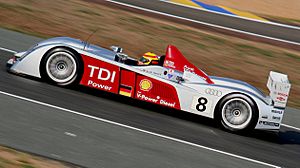
In 2005, after five wins with the R8, Audi took on a new challenge. They introduced a diesel engined prototype called the R10 TDI. It was the first diesel car to win at Le Mans. Other alternative fuels, like bio-ethanol, were also used. Peugeot also started using a diesel car in 2007 with their 908 HDi FAP.
In the 2008 race, the Audi won against the Peugeot by less than 10 minutes. For the 2009 24 Hours of Le Mans, Peugeot added a new energy-recovery system similar to those used in Formula One. Audi returned with a new car, the R15 TDI, but Peugeot won their first overall victory since 1993.
The 2010 race showed that endurance and reliability are key. Peugeot focused on speed, while Audi focused on reliability. All four Peugeots had to stop racing due to engine problems, while Audi finished 1-2-3.
The 2011 and 2012 races had several accidents. In 2011, two of the three factory Audis crashed heavily. The drivers were not seriously hurt, and no spectators were injured. The third Audi won the race. In the 2012 race, two factory Toyotas replaced Peugeot. One Toyota flipped, and its driver Anthony Davidson broke two bones in his back but was able to get out of the car. The other Toyota stopped due to mechanical problems, leading to another Audi victory.
In 2011, Le Mans became the main race of the Intercontinental Le Mans Cup. In 2012, it became the center of the FIA World Endurance Championship. The 2012 event was the first time a hybrid electric vehicle won the race, which was the Audi R18 e-tron quattro.
Modern Era (2014–Present)
Rules changed for 2014. All LMP1 cars had to have closed cockpits. There were also changes to hybrid systems and a new "slow zone" system.
Porsche returned to Le Mans in 2014 with a new LMP1 program. Nissan also returned in 2015. Audi stopped racing at Le Mans in 2016, and Nissan left after only one attempt in 2015.
Porsche won the race in 2015, 2016, and 2017 with its hybrid 919. Porsche is still the most successful manufacturer at Le Mans, with 19 overall wins.
In 2017, rules for LMP2 cars changed, meaning all prototype cars must have closed cockpits.
In 2018, Toyota won their first Le Mans. Toyota won again in 2019, 2020, 2021, and 2022.
The 2020 race was held without spectators for the first time due to the COVID-19 pandemic.
The Hypercar class was introduced in 2021. This class allows for Le Mans Hypercars and, since 2023, also LMDh cars to race. The 2021 race was postponed to August. For 2021 and 2022, older non-hybrid LMP1 cars were still allowed to race. Other cars in the hypercar class included Toyota and the private team Glickenhaus. The new Hypercar rules give manufacturers more freedom with car design. This has led to unique cars like the wingless Peugeot 9X8. The LMP2 rules were extended to 2027, with new LMP2 cars expected in 2028. Hydrogen-powered prototypes are also likely to be introduced in 2028. The former LMGTE class was replaced by LMGT3 in 2024.
Car Innovations
Le Mans has seen many new ideas in automotive design to help cars handle the track's challenges. These ideas were either required by rules or were attempts by manufacturers to gain an advantage. Some of these innovations later became part of everyday cars.
Aerodynamics
One key to Le Mans is high top speed because of the long straights. This means cars try to reach the highest speeds possible instead of relying on downforce for turns. Early cars were mostly street cars with parts removed to be lighter. But innovators like Bugatti started designing cars with better aerodynamics. These cars were nicknamed tanks because they looked like military tanks. They used simple curves to cover all the car's parts and increase top speed. After World War II, most manufacturers used smooth, closed bodies for better aerodynamics. A good example is the 1950 Cadillac Coupe de Ville entered by Briggs Cunningham. One of his Cadillacs was completely reshaped with a smooth aluminum body. It looked so unusual that the French press called it "Le Monstre." This focus on smooth shapes for less aerodynamic drag made Le Mans cars look very different from Grand Prix cars.
Over the years, car bodies became fully enclosed and lighter. Larger bodies with spoilers helped create more downforce for turns without increasing drag, allowing cars to maintain high speeds. Extended bodywork often focused on the car's rear, called long tail designs. The bodywork also started to cover the cockpit to reduce drag. However, open cockpits came and went as rules changed. Aerodynamics reached its peak in 1989 before the Mulsanne Straight was changed. In the 1988 race, a WM prototype taped over its engine openings. This allowed Roger Dorchy to set a speed record of 407 km/h (253 mph) on the Mulsanne Straight. However, the car was very hard to drive on other parts of the track, and its engine soon broke from lack of cooling. In the 1989 race, the Mercedes-Benz C9 reached 400 km/h (249 mph) during qualifying.
Engines
Many different types of engines have competed at Le Mans. Teams tried to find engines that were fast, used less fuel, and spent less time in the pits. Engine sizes have varied greatly, from tiny 569 cc engines to large 8,000 cc ones. Supercharging was an early way to increase power, first used in 1929. Turbocharging appeared in 1974.
The first car without a piston engine raced in 1963. Rover and British Racing Motors used a gas turbine engine, with mixed success. The American Howmet Corporation tried a turbine again in 1968, but it was not very successful. While these engines offered great power, they were hot and used a lot of fuel.
Another non-piston engine was the Wankel engine, also known as the rotary engine. Mazda used this compact engine since 1970. Like the turbine, it used a lot of fuel, but it was more successful. After many years of development, Mazda became the only winner of the race without a piston-powered engine, winning in 1991 with the 787B.
Alternative fuels also played a role. The first non-gasoline car appeared in 1949. The Delettrez Special was powered by a diesel engine. Another diesel car appeared the next year. While diesel engines appeared at other times, it wasn't until 2006 that a major manufacturer, Audi, invested in diesel and finally won with the R10 TDI.
Ethanol fuel was used in 1980 in a modified Porsche 911, which won its class. Other biological fuels returned in 2004. In 2008, biofuels (10% ethanol for petrol engines and biodiesel for diesel engines) were allowed. Audi was the first to use a new type of biodiesel.
Since 2009, new rules have allowed hybrid vehicles with energy recovery systems. In 2012, the first hybrid car won: the Audi R18 e-tron. This car used a flywheel hybrid system that powered the front wheels. It was only allowed to activate at speeds over 120 km/h. In the same year, Toyota also started with a hybrid car, the TS030.
By 2025, the Automobile Club de l’Ouest plans to introduce a hydrogen-electric prototype class. These cars might also be powered by a hydrogen combustion engine. Their performance is expected to be as good as the top Hypercar class.
Brakes
As cars got faster, brakes became very important for teams to slow down safely for turns like the Mulsanne Corner. Disc brakes were first used in 1953 on the Jaguar C-Type. In 1955, the Mercedes-Benz 300 SLR introduced the air brake, which used a large opening hood at the back of the car. Ford used quick-change brake rotors in 1966 to help them win their first Le Mans.
In the 1980s, anti-lock braking systems became common on most Group C cars. This was a safety feature to prevent cars from losing control at high speeds. By the late 1990s, reinforced carbon-carbon brakes were used for even better stopping power.
Winners and Records
Many manufacturers have won the overall race, and even more have won their specific classes. Porsche is the most successful brand, with nineteen overall victories, including seven in a row from 1981 to 1987. They also have 107 class victories. Audi is next with thirteen wins, and Ferrari has eleven. Since 2000, Audi dominated, winning 13 times in 15 years. Jaguar has seven wins. Bentley, Alfa Romeo, and Ford each won four races in a row. In 2018, Toyota became the second Japanese brand to win, after Mazda in 1991. Mazda is also the only company to win with a rotary engine.

Three drivers stand out for their number of wins. Jacky Ickx held the record with six wins between 1969 and 1982. His racing partner, Derek Bell, had five wins. However, Tom Kristensen from Denmark broke this record with nine wins between 1997 and 2013, including six in a row.
Henri Pescarolo won the race four times and holds the record for the most Le Mans appearances at 33. Graham Hill is the only driver to win the "Triple Crown of Motorsport" (Indianapolis 500, Monaco Grand Prix, and 24 Hours of Le Mans).
Accidents and Safety
Le Mans has had many serious accidents because of the very high speeds on the track. The largest accident was in 1955, when at least 81 spectators and driver Pierre Levegh were killed. After this disaster, many races were canceled, and new safety rules were put in place for both drivers and spectators.
Almost every decade has seen bad accidents. In 1972, Jo Bonnier was killed when his car crashed into a forest. The 1980s saw some of the worst accidents. Even though barriers were installed, there were no chicanes on the Mulsanne Straight. Cars could go over 390–400 km/h (240–250 mph) there. In 1981, Thierry Boutsen crashed, killing a marshal. In the same race, Jean-Louis Lafosse was also killed on the Mulsanne Straight.
In 1984, British driver John Sheldon crashed at over 320 km/h (200 mph) at the Mulsanne Kink. His car went through the barriers and into the trees. The explosion was so strong that the nearby woods caught fire. Sheldon survived with severe burns, but a track marshal was killed.
In 1999, the Mercedes-Benz CLR cars had problems with aerodynamics, causing them to become airborne and flip three times. Mark Webber was the driver whose car flipped twice. The worst accident happened during the race when Peter Dumbreck's car flew over the safety fence and landed in the woods. No drivers were seriously hurt in these accidents. Mercedes-Benz then stopped its sports car racing program.
In 2011, two serious accidents happened to two of the three factory Audis. Both drivers, Allan McNish and Mike Rockenfeller, crashed heavily but were not injured. Audi had started using closed-cockpit cars in 2011, which was believed to have saved the drivers from serious harm. Because of these accidents, rules in 2014 required all top-class cars to have closed cockpits.
In 2012, Anthony Davidson of Toyota crashed and became airborne before hitting the barrier. He broke bones in his back.
In 2013, Allan Simonsen died after crashing into the barriers at Tertre Rouge.
Race Coverage
Many TV channels have covered the 24 Hours of Le Mans. In the United States, SPEED Channel, and later Fox Sports 1 and 2, showed the entire race live for several years.
In Europe, Eurosport has shown the entire race, including qualifying and other events, since 2008. They also provide live streaming online. Since 2018, Eurosport's parent company also broadcasts the race in the United States on Motor Trend TV.
The race is also broadcast in English on the radio by Radio Le Mans.
Classic Car Races

Since 2001, the ACO has allowed the "Le Mans Legend" event to take place on the full Circuit de la Sarthe. These are exhibition races for classic cars that previously raced at Le Mans or are similar to them. Each year, cars from a specific era can participate. Many amateur drivers take part, but some famous professional drivers have also returned to race cars they once drove.
Since 2002, the "Le Mans Classic" has been held every two years on the full 13 km (8.1 mi) circuit in July. These races also last for a full 24-hour day and night cycle. Cars from the same era race at the same time. A team usually has a car in each class. The team with the most points across all classes wins. The classes are based on the era when the cars would have competed. Drivers need a special racing license. This event also includes a large car show and auction.
See also
 In Spanish: 24 Horas de Le Mans para niños
In Spanish: 24 Horas de Le Mans para niños
- 24 Hours of Le Mans (motorcycle race)
- Petit Le Mans
- Road to Le Mans
- 24 Hours of LeMons
- Le Mans 24 Hours video games
- List of 24 Hours of Le Mans winners
- List of 24 Hours of Le Mans records
- Triple Crown of Motorsport
- Radio Le Mans
- Musée des 24 Heures du Mans
- FIA World Endurance Championship
- European Le Mans Series
- Le Mans Cup
- Asian Le Mans Series





